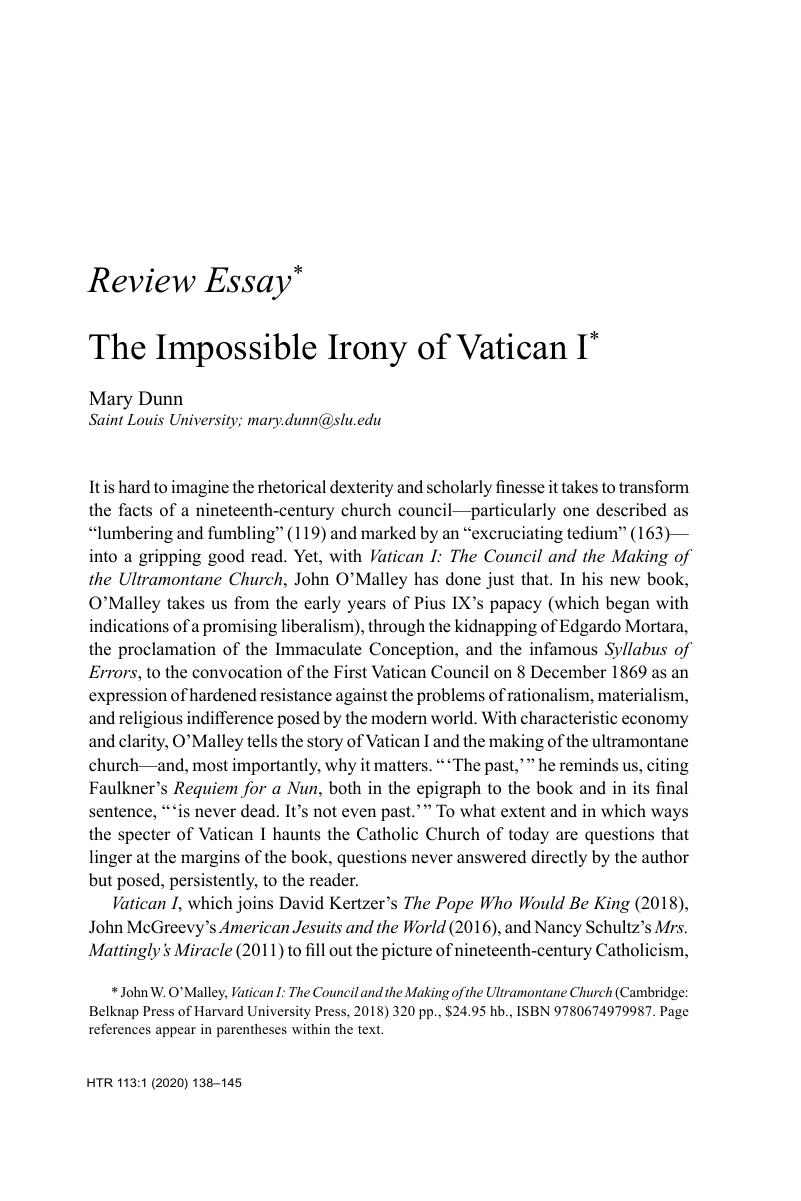Article contents
The Impossible Irony of Vatican I
Published online by Cambridge University Press: 27 December 2019
Abstract

- Type
- Review Essay
- Information
- Copyright
- © Copyright by the President and Fellows of Harvard College, 2020
Footnotes
John W. O’Malley, Vatican I: The Council and the Making of the Ultramontane Church (Cambridge: Belknap Press of Harvard University Press, 2018) 320 pp., $24.95 hb., ISBN 9780674979987. Page references appear in parentheses within the text.
References
1 Robert A. Orsi, History and Presence (Cambridge: Belknap Press of Harvard University Press, 2016) 3.
2 Charles Hirschkind, The Ethical Soundscape: Cassette Sermons and Islamic Counterpublics (New York: Columbia University Press, 2006) 21.
3 See, for example, Orsi, History and Presence; Isaac Weiner, Religion Out Loud: Religious Sound, Public Space, and American Pluralism (New York: New York University Press, 2014); Saba Mahmood, Politics of Piety: The Islamic Revival and the Feminist Subject (Princeton: Princeton University Press, 2011); Amira Mittermaier, Dreams that Matter: Egyptian Landscapes of the Imagination (Berkeley: University of California Press, 2011); Hirschkind, Ethical Soundscape; Talal Asad, Formations of the Secular: Christianity, Islam, Modernity (Stanford, CA: Stanford University Press, 2003); and Dipesh Chakrabarty, Provincializing Europe: Postcolonial Thought and Historical Difference (Princeton: Princeton University Press, 2000).
4 Recent work that challenges the sufficiency of natural and social scientific methods as means of addressing the data of religion includes Tyler Roberts, “Between the Lines: Exceeding Historicism in the Study of Religion,” JAAR 74 (2006) 697–719; Robert A. Orsi, “2+2=5, or the Quest for an Abundant Empiricism,” Spiritus: A Journal of Christian Spirituality 6 (2006) 113–21; idem, “The Problem of the Holy,” in The Cambridge Companion to Religious Studies (ed. Robert A. Orsi; Cambridge: Cambridge University Press, 2012) 84–105; idem, History and Presence; and Michael Jackson, The Palm at the End of the Mind: Relatedness, Religiosity, and the Real (Durham: Duke University Press, 2009). Jackson, The Palm at the End of the Mind, 100.
5 William James, The Varieties of Religious Experience (Cambridge: Harvard University Press, 1985); John Dewey, Essays in Experimental Logic (New York: Dover, 1953); idem, Logic: The Theory of Inquiry (New York: Holt, 1938); Richard Rorty, Philosophy and the Mirror of Nature (Princeton: Princeton University Press, 1980); idem, Contingency, Irony, and Solidarity (Cambridge: Cambridge University Press, 1989); and Hannah Arendt, Between Past and Future: Eight Exercises in Political Thought (New York, Viking, 1968) 265–80.
- 1
- Cited by


